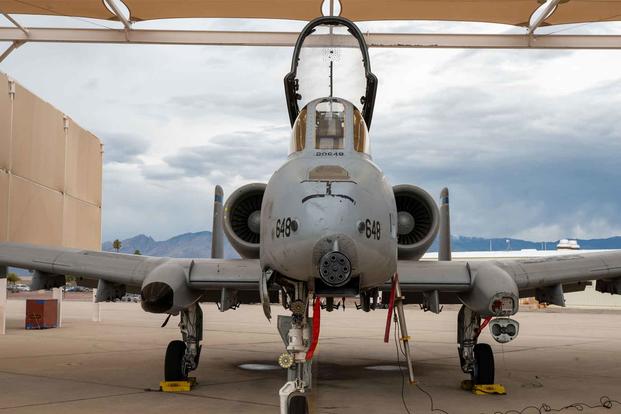The Air Force is hoping to retire more A-10 Warthogs in 2025, as the service continues to readjust its overall strategies and future aircraft based on China's growing threat in the Pacific.
In their 2025 budget request, Air Force officials are hoping to retire 250 aircraft -- with 56 of those divestments being A-10s. If passed, it would mark the largest number of the close-air support stalwarts sent to the boneyard -- the final resting place for scrapped aircraft.
Congress allowed the service to part with 21 A-10s -- the first such retirements approved in the 21st century -- as part of its 2023 defense policy bill, Military.com reported. The 2024 National Defense Authorization Act "eases current restrictions on retiring A-10 aircraft to allow the Air Force to retire 42 A-10 aircraft" in fiscal 2024, according to a Senate fact sheet.
The close-support aircraft, with a 57-foot, 6-inch wingspan, has been in service since the 1970s. The signature "brrrttt" noise emitted from its 30mm Gatling-style guns, which aided troops extensively in Iraq and Afghanistan in addition to playing a key role in the first Gulf War, helped garner a fanatic following among service members, as well as Washington lawmakers who have fervently protected it from retirement.
But that support seems to be fading. More A-10 squadrons are starting to shed their aircraft.
It was announced earlier this month that Maryland's Warfield Air National Guard Base at Martin State Airport is the preferred location to transition from a flying mission with aging A-10 aircraft to a cyber wing mission -- leaving the future of those jobs up in the air.
"Divestment of the 21 A-10s at Warfield ANGB is forecasted to begin in fall 2024," the Air Force said in a press release. "Manpower numbers are expected to remain neutral but will be finalized over the next year."
Last month, the 355th Wing at Davis-Monthan Air Force Base in Arizona began divesting its A-10 fleet. Air Force officials said in a press release announcing those changes that the service "is planning to divest the entire fleet of A-10 aircraft within the next 3-5 years" and that pilots and maintainers will move on to the fifth-generation F-35 Lightning II fighter jet.
"The A-10 has been the symbol of Davis-Monthan Air Force Base for many years, and it will continue to be a symbol for the airmen of DM, a symbol of their commitment, excellence and service," Col. Scott Mills, 355th Wing commander and A-10 pilot, said in the news release. "For now, we're divesting a single squadron during the summer-fall timeframe of 2024."
As Congress moves toward retiring more A-10 Warthogs from service, the Air Force also aims over the next three years to cut the number of elite airmen responsible for calling in close-air support on the battlefield.
Rose Riley, a Department of the Air Force spokeswoman, told Military.com last year that the service plans to shrink the Tactical Air Control Party, or TACP, job field to about 2,130 positions -- a decrease of 44%, according to the service. The Air Force said the manning is now "roughly" 3,700 airmen.
Over three fiscal years, the Air Force is asking to decrease TACPs by "44% to approximately 2,130 positions with a reduction of roughly 370 positions in FY23, 610 positions in FY24, and 600 positions in FY25," Riley told Military.com last year in an emailed statement.
Air Force officials did not immediately respond when asked Monday about how that plan was proceeding.
Troops-In-Contact, an advocacy group led by A-10 and air support veterans, issued a statement after the cuts were revealed saying close-air support, or CAS, is crucial to the military. The group argued that the results of cutting TACPs could be deadly. The group has also fought against cuts to the A-10 Warthog.
"If successful, this plan would kill the CAS profession and cripple America's CAS capability," the group wrote on its website. "Ground troops would be supported, if at all, by CAS amateurs in a small, expensive fleet of fragile aircraft that are far less effective. In low-intensity conflict, that will cost lives."
The A-10 retirements come as the Air Force continues to invest in the F-35, which was billed early on as a close-air support replacement for the Warthog. It also comes as the service pivots overall to a focus on the Pacific and China, leaving the Middle East in the rearview.
Dan Grazier, a senior policy fellow with the Project on Government Oversight, a nonpartisan, nonprofit watchdog group, obtained a copy of an A-10 and F-35 flyoff testing report that did not paint the F-35 as the clear winner between the two, he reported.
Grazier said the continued retirements of the A-10 will leave the service empty-handed when it comes to close-air support abilities.
"It's going to leave a capability gap," Grazier told Military.com in an interview Monday.
Related: After Recruiting Woes, Air Force Cuts Planned Troop Totals by 8,000 for Coming Year














